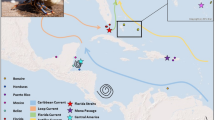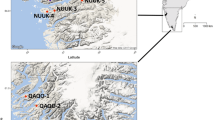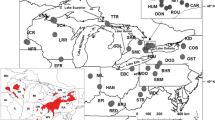Abstract
Spatial and temporal genetic heterogeneity in the sequences of nuclear protein-coding genes were investigated in populations of the blue crab, Callinectes sapidus. Haplotype frequencies of these novel markers were determined for adult crabs collected along 300 km in the northern Gulf of Mexico in two different years (2010 and 2011), as well as for megalopal recruits collected in 2010. Tests of genetic differentiation among all locations and between locations spanning known genetic breaks in other species were conducted. In addition, samples from distant locations within the range of C. sapidus were used to assess genetic divergence on a broader geographic scale. Significant between-year differences were found for adults at one location and near significant spatial differentiation was found across northern Gulf of Mexico locations in 2010. These results suggest that although the large population sizes and meroplanktonic life history of blue crabs promote widespread gene flow on a regional scale, genetic composition can change over just one year. Substantial divergence between the northern Gulf of Mexico and Venezuela suggests the possibility that temporal shifts in haplotype frequencies could result from variation in the rate of immigration from genetically distinct source populations. The possible effects of the Deepwater Horizon Oil Spill and attendant fisheries closures during the sampling phase of this study are also considered.

Similar content being viewed by others
References
Barron MG (2012) Ecological impacts of the Deepwater Horizon Oil Spill: implications for immunotoxicity. Toxicol Pathol 40(2):315–320. doi:10.1177/0192623311428474
Bazin E, Glémin S, Galtier N (2006) Population size does not influence mitochondrial genetic diversity in animals. Science 312(5773):570–572
Berthelemy-Okazaki NJ, Okazaki RK (1997) Population genetics of the blue crab Callinectes sapidus from the Northwestern Gulf of Mexico. Gulf Mex Sci 1:35–39
Bilodeau AL, Felder DL, Neigel JE (2005) Population structure at two geographic scales in the burrowing crustacean Callichirus islagrande (Decapoda, Thalassinidea): historical and contemporary barriers to planktonic dispersal. Evolution 59(10):2125–2138
Bradbury IR, Hubert S, Higgins B, Borza T, Bowman S, Paterson IG, Snelgrove PVR, Morris CJ, Gregory RS, Hardie DC, Hutchings JA, Ruzzante DE, Taggart CT, Bentzen P (2010) Parallel adaptive evolution of Atlantic cod on both sides of the Atlantic Ocean in response to temperature. Proc Biol Sci 277(1701):3725–3734. doi:10.1098/rspb 2010.0985
Calderón I, Turon X (2010) Temporal genetic variability in the Mediterranean common sea urchin Paracentrotus lividus. Mar Ecol Prog Ser 408:149–159. doi:10.3354/meps08576
Chapuis M-P, Estoup A (2007) Microsatellite null alleles and estimation of population differentiation. Mol Biol Evol 24(3):621–631. doi:10.1093/molbev/msl191
Coblentz FE, Towle DW, Shafer TH (2006) Expressed sequence tags from normalized cDNA libraries prepared from gill and hypodermal tissues of the blue crab, Callinectes sapidus. Comp Biochem Physiol Part D Genomics Proteomics 1(2):200–208
Costlow JD (1967) The effect of salinity and temperature on survival and metamorphosis of megalops of the blue crab Callinectes sapidus. Helgol Mar Res 15(1):84–97
Costlow JDJ, Bookhout CG (1959) The larval development of Callinectes sapidus Rathbun reared in the laboratory. Biol Bull 116(3):373–396
Cronin TW (1982) Estuarine retention of larvae of the crab Rhithropanopeus harrisii. Estuar Coast Shelf Sci 15(2):207–220. doi:10.1016/0272-7714(82)90028-2
Dakin EE, Avise JC (2004) Microsatellite null alleles in parentage analysis. Heredity 93(5):504–509
Darnell MZ, Rittschof D, Darnell KM, McDowell RE (2009) Lifetime reproductive potential of female blue crabs Callinectes sapidus in North Carolina, USA. Mar Ecol Prog Ser 394:153–163
Darnell MZ, Darnell KM, McDowell RE, Rittschof D (2010) Postcapture survival and future reproductive potential of ovigerous blue crabs Callinectes sapidus caught in the central North Carolina pot fishery. Trans Am Fish Soc 139(6):1677–1687
Daugherty FM (1952) The blue crab investigation. Tex J Sci 4(1):77–84
Dempster AP, Laird NM, Rubin DB (1977) Maximum likelihood from incomplete data via the EM algorithm. J Roy Stat Soc Ser B Stat Methodol 39(1):1–38
Dickinson GH, Rittschof D, Latanich C (2006) Spawning biology of the blue crab, Callinectes sapidus, in North Carolina. Bull Mar Sci 79(2):273–285
Drumm DT, Kreiser B (2012) Population genetic structure and phylogeography of Mesokalliapseudes macsweenyi (Crustacea: Tanaidacea) in the northwestern Atlantic and Gulf of Mexico. J Exp Mar Biol Ecol 412:58–65. doi:10.1016/j.jembe.2011.10.023
Epifanio CE, Garvine RW (2001) Larval transport on the Atlantic continental shelf of North America: a review. Estuar Coast Shelf Sci 52(1):51–77
Excoffier L, Laval G, Schneider S (2005) Arlequin (version 3.0): an integrated software package for population genetics data analysis. Evol Bioinform Online 1:47–50
Forward RB Jr, Cohen JH, Darnell MZ, Saal A (2005) The circatidal rhythm in vertical swimming of female blue crabs, Callinectes sapidus, during their spawning migration: a reconsideration. J Shellfish Res 24(2):587–590
Fucik KW, Carr KA, Balcom BJ (1995) Toxicity of oil and dispersed oil to the eggs and larvae of seven marine fish and invertebrates from the Gulf of Mexico. ASTM Spec Tech Publ 1252:135–171
Gaines SD, Gaylord B, Largier JL (2003) Avoiding current oversights in marine reserve design. Ecol Appl 13(sp1):32–46
Galarza JA, Carreras-Carbonell J, Macpherson E, Pascual M, Roques S, Turner GF, Rico C (2009) The influence of oceanographic fronts and early-life-history traits on connectivity among littoral fish species. Proc Natl Acad Sci USA 106(5):1473–1478. doi:10.1073/pnas.0806804106
Gelpi CGJ, Condrey RE, Fleeger JW, Dubois SF (2009) Discovery, evaluation, and implications of Blue Crab, Callinectes sapidus, spawning, hatching, and foraging grounds in federal (US) waters offshore of Louisiana. Bull Mar Sci 85:203–222
Gelpi CJ, Fry B, Condrey R, Fleeger J, Dubois S (2013) Using δ13C and δ15N to determine the migratory history of offshore Louisiana blue crab spawning stocks. Mar Ecol Prog Ser 494:205–218. doi:10.3354/meps10540
Graham DJ, Perry H, Biesiot P, Fulford R (2012) Fecundity and egg diameter of primiparous and multiparous blue crab Callinectes sapidus (Brachyura: Portunidae) in Mississippi waters. J Crust Biol 32(1):49–56. doi:10.1163/193724011x615325
Guo SW, Thompson EA (1992) Performing the exact test of Hardy–Weinberg proportion for multiple alleles. Biometrics 48(2):361–372
Hamilton P, Donohue K, Leben R, Lugo-Fernández A, Green R (2011) Loop current observations during spring and summer of 2010: description and historical perspective. Geophys Monogr Ser 195:117–130
Harrigan RJ, Mazza ME, Sorenson MD (2008) Computation vs. cloning: evaluation of two methods for haplotype determination. Mol Ecol Resour 8(6):1239–1248. doi:10.1111/j.1755-0998.2008.02241.x
Heck KLJ, Coen LD, Morgan SG (2001) Pre- and post-settlement factors as determinants of juvenile blue crab Callinectes sapidus abundance: results from the north-central Gulf of Mexico. Mar Ecol Prog Ser 222:163–176. doi:10.3354/meps222163
Hedgecock D (1994) Does variance in reproductive success limit effective population sizes of marine organisms? Genetics and evolution of aquatic organisms. Chapman and Hall, London
Hench JL, Forward RB Jr, Carr SD, Rittschof D, Luettich RA Jr (2004) Testing a selective tidal-stream transport model: observations of female blue crab (Callinectes sapidus) vertical migration during the spawning season. Limnol Oceanogr 49(5):1857–1870
Herke SW, Foltz DW (2002) Phylogeography of two squid (Loligo pealei and L. plei) in the Gulf of Mexico and northwestern Atlantic Ocean. Mar Biol 140(1):103–115. doi:10.1007/s002270100680
Hilbish TJ (1985) Demographic and temporal structure of an allele frequency cline in the mussel Mytilus edulis. Mar Biol 86(2):163–171
Hines AH, Jivoff PR, Bushmann PJ, van Montfrans J, Reed SA, Wolcott DL, Wolcott TG (2003) Evidence for sperm limitation in the blue crab, Callinectes sapidus. Bull Mar Sci 72(2):287–310
Hsueh P-W, McClintock JB, Hopkins TS (1993) Population dynamics and life history characteristics of the blue crabs Callinectes similis and C. sapidus in bay environments of the northern Gulf of Mexico. Mar Ecol 14(3):239–257
Huang X, Madan A (1999) CAP3: a DNA sequence assembly program. Genome Res 9(9):868–877. doi:10.1101/gr.9.9.868
Johnson MS, Black R (1982) Chaotic genetic patchiness in an intertidal limpet, Siphonaria sp. Mar Biol 70(2):157–164
Johnson DR, Perry JM (1999) Blue crab larval dispersion and retention in the Mississippi Bight. Bull Mar Sci 65(1):129–149
Koehn RK, Newell RI, Immermann F (1980) Maintenance of an aminopeptidase allele frequency cline by natural selection. Proc Natl Acad Sci USA 77(9):5385–5389
Kordos LM, Burton RS (1993) Genetic differentiation of Texas Gulf Coast populations of the blue crab Callinectes sapidus. Mar Biol 117(2):227–233
Larsson LC, Laikre L, Palm S, Andre C, Carvalho GR, Ryman N (2007) Concordance of allozyme and microsatellite differentiation in a marine fish, but evidence of selection at a microsatellite locus. Mol Ecol 16(6):1135–1147. doi:10.1111/j.1365-294X.2006.03217.x
Librado P, Rozas J (2009) DnaSP v5: a software for comprehensive analysis of DNA polymorphism data. Bioinformatics 25(11):1451–1452. doi:10.1093/bioinformatics/btp187
McCrea-Strub A, Kleisner K, Sumaila UR, Swartz W, Watson R, Zeller D, Pauly D (2011) Potential impact of the Deepwater Horizon Oil Spill on commercial fisheries in the Gulf of Mexico. Fisheries 36(7):332–336. doi:10.1080/03632415.2011.589334
McMillen-Jackson AL, Bert TM (2004) Mitochondrial DNA variation and population genetic structure of the blue crab Callinectes sapidus in the eastern United States. Mar Biol 145(4):769–777
McMillen-Jackson AL, Bert TM, Steele P (1994) Population genetics of the blue crab Callinectes sapidus: modest population structuring in a background of high gene flow. Mar Biol 118(1):53–65
Meiklejohn CD, Montooth KL, Rand DM (2007) Positive and negative selection on the mitochondrial genome. Trends Genet 23(6):259–263. doi:10.1016/j.tig.2007.03.008
Metcalf KS, van Montfrans J, Lipcius RN, Orth RJ (1995) Settlement indices for blue crab megalopae in the York River, Virginia: temporal relationships and statistical efficiency. Bull Mar Sci 57:781–792
Millikin MR, Williams AB (1984) Synopsis of biological data on the blue crab, Callinectes sapidus Rathbun. National Oceanic and Atmospheric Administration, National Marine Fisheries Service 138
Morgan SG, Fisher JL (2010) Larval behavior regulates nearshore retention and offshore migration in an upwelling shadow and along the open coast. Mar Ecol Prog Ser 404:109–126. doi:10.3354/meps08476
Morgan SG, Zimmer-Faust RK, Heck KL Jr, Coen LD (1996) Population regulation of blue crabs Callinectes sapidus in the northern Gulf of Mexico: postlarval supply. Mar Ecol Prog Ser 133:73–88. doi:10.3354/meps133073
Neigel JE (2009) Population genetics and biogeography of the Gulf of Mexico. In: Felder DF, Camp CK (eds) Gulf of Mexico—its origins, waters, and biota: biota. Texas A&M University Press, College Station, Texas
NOAA (2013) National Oceanographic and Atmospheric Administration, National Marine Fisheries Service, Office of Science and Technology, Commercial Fisheries. Annual commercial landing statistics. http://www.st.nmfs.noaa.gov/st1/commercial/landings/annual_landings.html. Accessed Jan 9 2013
Nowlin WD, Jochens AE, DiMarco SF, Reid RO, Howard MK (2005) Low-frequency circulation over the Texas–Louisiana continental shelf. In: Sturges W, Lugo-Fernandez A (eds) Circulation in the Gulf of Mexico: observations and models, vol 161. Geophysical Monograph-American Geophysical Union, Washington, DC, p 22
Ohlmann JC, Niiler PP (2001) A two-dimensional response to a tropical storm on the Gulf of Mexico shelf. J Mar Syst 29(1–4):87–99
Ohlmann JC, Niiler PP (2005) Circulation over the continental shelf in the northern Gulf of Mexico. Prog Oceanogr 64(1):45–81
Ohlmann JC, Niiler PP, Fox CA, Leben RR (2001) Eddy energy and shelf interactions in the Gulf of Mexico. J Geophys Res (Oceans) 106(C2):2605–2620. doi:10.1029/1999jc000162
Palumbi SR (1994) Genetic divergence, reproductive isolation, and marine speciation. Annu Rev Ecol Syst 25:547–572
Palumbi SR (2003) Population genetics, demographic connectivity, and the design of marine reserves. Ecol Appl 13(sp1):146–158
Palumbi S, Martin A, Romano S, McMillan W, Stice L, Grabowski G (1991) The simple fool’s guide to PCR. Department of Zoology and Kewalo Marine Laboratory, University of Hawaii, Honolulu
Penland S, Suter JR (1989) The geomorphology of the Mississippi River chenier plain. Mar Geol 90(4):231–258. doi:10.1016/0025-3227(89)90127-8
Perry HM (1975) The blue crab fishery in Mississippi. Gulf Res Rep 5(1):39–57
Perry HM, McIlwain TD (1986) Species profiles: life histories and environmental requirements of coastal fishes and invertebrates (Gulf of Mexico): Blue crab (Callinectes sapidus). US Fish and Wildlife Service, Biological Report
Perry HM, Eleuterius CK, Trigg CB, Warren JR (1995) Settlement patterns of Callinectes sapidus megalopae in Mississippi Sound: 1991, 1992. Bull Mar Sci 57(3):821–833
Perry H, Johnson DR, Larsen K, Trigg C, Vukovich F (2003) Blue crab larval dispersion and retention in the Mississippi Bight: testing the hypothesis. Bull Mar Sci 72(2):331–346
Platt AR, Woodhall RW, George AL Jr (2007) Improved DNA sequencing quality and efficiency using an optimized fast cycle sequencing protocol. BioTechniques 43(1):58–62
Rabalais NN, Burditt FR, Coen LD, Cole BE, Eleuterius C, Heck KL, McTigue TA, Morgan SG, Perry HM, Truesdale FM, ZimmerFaust RK, Zimmerman RJ (1995) Settlement of Callinectes sapidus megalopae on artificial collectors in four Gulf of Mexico estuaries. Bull Mar Sci 57(3):855–876
Raymond M, Rousset F (1995) An exact test for population differentiation. Evolution 49(6):1280–1283
Rice W (1989) Analyzing tables of statistical tests. Evolution 43:223–225
Robles R, Schubart C, Conde J, Carmona-Suárez C, Alvarez F, Villalobos J, Felder D (2007) Molecular phylogeny of the American Callinectes Stimpson, 1860 (Brachyura: Portunidae), based on two partial mitochondrial genes. Mar Biol 150(6):1265–1274
Rousset F (1997) Genetic differentiation and estimation of gene flow from F-statistics under isolation by distance. Genetics 145:1219–1228
Rousset F (2008) Genepop’007: a complete re-implementation of the genepop software for Windows and Linux. Mol Ecol Resour 8(1):103–106
Rousset F, Raymond M (1995) Testing heterozygote excess and deficiency. Genetics 140(4):1413–1419
Rozen S, Skaletsky HJ (2000) Primer3 on the WWW for general users and for biologist programmers. In: Krawetz SMS (ed) Bioinformatics methods and protocols: methods in molecular biology. Humana Press, Totowa, NJ, pp 365–386
Ryman N, Palm S (2006) POWSIM: a computer program for assessing statistical power when testing for genetic differentiation. Mol Ecol Notes 6(3):600–602. doi:10.1111/j.1471-8286.2006.01378.x
Shaklee JB, Bentzen P (1998) Genetic identification of stocks of marine fish and shellfish. Bull Mar Sci 62(2):589–621
Steele P (1991) Population dynamics and migration of the blue crab, Callinectes sapidus (Rathbun), in the Eastern Gulf of Mexico. Proc Gulf Caribb Fish Inst 40:241–244
Stephens M, Donnelly P (2003) A comparison of Bayesian methods for haplotype reconstruction from population genotype data. Am J Hum Genet 73(5):1162–1169
Stephens M, Smith NJ, Donnelly P (2001) A new statistical method for haplotype reconstruction from population data. Am J Hum Genet 68(4):978–989
St-Onge P, Sévigny J-M, Strasser C, Tremblay R (2013) Strong population differentiation of softshell clams (Mya arenaria) sampled across seven biogeographic marine ecoregions: possible selection and isolation by distance. Mar Biol 160(5):1065–1081. doi:10.1007/s00227-012-2157-5
Stuck KC, Perry HM (1981) Observations on the distribution and seasonality of portunid megalopae in Mississippi coastal waters. Gulf Res Rep 7(1):93–95
Sulkin SD, Van Heukelem WF (1986) Variability in the length of the megalopal stage and its consequence to dispersal and recruitment in the portunid crab Callinectes sapidus Rathbun. Bull Mar Sci 39:269–278
Swearer SE, Shima JS, Hellberg ME, Thorrold SR, Jones GP, Robertson DR, Morgan SG, Selkoe KA, Ruiz GM, Warner RR (2002) Evidence of self-recruitment in demersal marine populations. Bull Mar Sci 70:251–271
Therkildsen NO, Hemmer-Hansen J, Als TD, Swain DP, Morgan MJ, Trippel EA, Palumbi SR, Meldrup D, Nielsen EE (2013) Microevolution in time and space: SNP analysis of historical DNA reveals dynamic signatures of selection in Atlantic cod. Mol Ecol 22(9):2424–2440. doi:10.1111/mec.12260
Thorrold SR, Jones GP, Hellberg ME, Burton RS, Swearer SE, Neigel JE, Morgan SG, Warner RR (2002) Quantifying larval retention and connectivity in marine populations with artificial and natural markers. Bull Mar Sci 70(1):291–308
Treml EA, Roberts JJ, Chao Y, Halpin PN, Possingham HP, Riginos C (2012) Reproductive output and duration of the pelagic larval stage determine seascape-wide connectivity of marine populations. Integr Comp Biol 52(4):525–537. doi:10.1093/icb/ics101
Van Oosterhout C, Hutchinson WF, Wills DPM, Shipley P (2004) Micro-checker: software for identifying and correcting genotyping errors in microsatellite data. Mol Ecol Notes 4(3):535–538
Varney RL, Galindo-Sánchez CE, Cruz P, Gaffney PM (2009) Population genetics of the eastern oyster Crassostrea virginica (Gmelin, 1791) in the Gulf of Mexico. J Shellfish Res 28(4):855–864. doi:10.2983/035.028.0415
Wang SY, Stickle WB (1987) Bioenergetics, growth and molting of the blue crab, Callinectes sapidus, exposed to the water-soluble fraction of South Louisiana crude oil. Pollut Physiol Estuar Org 17:107
Waters JM, Roy MS (2004) Phylogeography of a high-dispersal New Zealand sea-star: does upwelling block gene-flow? Mol Ecol 13(9):2797–2806. doi:10.1111/j.1365-294X.2004.02282.x
Weir BS, Cockerham CC (1984) Estimating F-statistics for the analysis of population structure. Evolution 38(6):1358–1370
Whitehead A, Dubansky B, Bodinier C, Garcia TI, Miles S, Pilley C, Raghunathan V, Roach JL, Walker N, Walter RB, Rice CD, Galvez F (2011) Genomic and physiological footprint of the Deepwater Horizon oil spill on resident marsh fishes. Proc Natl Acad Sci. doi:10.1073/pnas.1109545108
Zhang Z, Schwartz S, Wagner L, Miller W (2000) A greedy algorithm for aligning DNA sequences. J Comput Biol 7(1–2):203–214
Acknowledgments
This research was made possible by grants from BP/The Gulf of Mexico Research Initiative, the National Science Foundation (OCE-0315995 and NSF (2010)-PFUND-214), and the Louisiana Board of Regents (ENH_2008–09). Special thanks to the Louisiana Department of Wildlife and Fisheries, the Army Corps of Engineers, the University of New Orleans, the Louisiana Universities Marine Consortium (LUMCON), the National Marine Fisheries Service, and the Texas Parks and Wildlife Department for assistance with sampling. Samples from the University of Louisiana at Lafayette Zoological Collection were kindly provided by Darryl Felder who, along with Michael Hellberg, Lawrence Rozas, Caryl Chlan, and two anonymous reviewers, provided comments that significantly improved this manuscript.
Author information
Authors and Affiliations
Corresponding author
Additional information
Communicated by S. Uthicke.
Electronic supplementary material
Below is the link to the electronic supplementary material.
Rights and permissions
About this article
Cite this article
Yednock, B.K., Neigel, J.E. An investigation of genetic population structure in blue crabs, Callinectes sapidus, using nuclear gene sequences. Mar Biol 161, 871–886 (2014). https://doi.org/10.1007/s00227-013-2387-1
Received:
Accepted:
Published:
Issue Date:
DOI: https://doi.org/10.1007/s00227-013-2387-1




